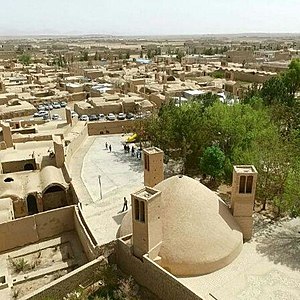Sharifabad, Ardakan
Sharifabad
شریف آباد اردکان | |
|---|---|
village | |
 Traditional architecture of the village | |
| Coordinates: 32°18′36″N 54°01′03″E / 32.31000°N 54.01750°E | |
| Country | |
| Province | Yazd |
| County | Ardakan |
| Population (2006) | |
| • Total | 4,000 |
| Time zone | UTC+3:30 (IRST) |
| • Summer (DST) | UTC+4:30 (IRDT) |
Sharifabad, Ardakan (Persian: شریف آباد, also romanized as Sharfava is a village in the Central District of Ardakan County, Yazd Province, Iran. At the 2006 census, its population was 4000.[1] This village is one of the Zoroastrian centres of Iran, and there are numerous holy sites for Zoroastrians in Sharifabad, this village is near Ardakan. Each summer thousands of Zoroastrians from around the world gather there for pilgrimage.[2] It is a village on the outskirts of Ardakan in a hot and dry climate with the passage of the 1000-year-old Qutbabad aqueduct. Both Muslims and Zoroastrians live in the village. Muslims worship to their mosque and Zoroastrians go to the fire temple of the village and respect each other's beliefs.[3][4] Regarding the history of Sharifabad, Ardakan is mentioned in the book of Rostam Biliwani that: It was formerly Shahriabad and later renamed Sharafabad and Sharifabad
Sharifabad Zoroastrian religious customs
In Zoroastrian history, Sharifabad Ardakan has been of great historical and research importance for a long time as "the most important center for preserving traditional and Zoroastrian beliefs in Iran and the residence of the great priests for several centuries." Due to the status and importance of Sharifabad, the famous English writer Mary Boyce.[5] has named her book "A PERSIAN _STRONGHOLD OF ZOROASTRIANISM", a vivid and sincere picture that Boyce presents of the simple, deeply honest and religious life of the Zoroastrian villagers of Sharifabad. It is valuable for research in contemporary Zoroastrian beliefs and mirrors.
Hiromba
The festival of fire called Hiromba (making bonfires), elsewhere known as Sadeh, is celebrated in Sharifabad.[2][6]

Occupations

The occupations of the people of Sharifabad in the past were mainly agriculture[5] and they farmed in the deserts of Esmatabad and Allahabad, but over time, with the decrease of aqueduct and groundwater, they turned to industrial, production and service jobs. Currently, a number of Muslim people in this village are successful craftsmen and producers and play a role in the tile, ceramic and glass industries of Yazd province. They also immigrated to Canada and the United States and are successful in their jobs and lives.[7]
Zoroastrian relations with Mumbai
The need to review the rules and regulations of the Zoroastrians of India led them to seek help from their counterparts in Iran,[8] and therefore sent a person named Behnam Nariman Houshang with various questions about the rules of the Zoroastrian religion to the priests of Sharifabad and Torkabad villages. This journey was not only the first field of knowledge of the Zoroastrians of Yazd about the Persians of India, but it caused the continuation of their relations until three hundred years later. The presence of the East India Company in India and the good relations of the Indian Persians with this company had provided them with trade conditions, so the Zoroastrians of Sharifabad and other Zoroastrian villages of Yazd established good trade relations with Mumbai and some emigrated there. Mankeji Limji Houshangpour Hatria, whose ancestors were Iranian immigrants to India during the Safavid era, traveled to Iran and helped to improve the life of the Zoroastrians in Yazd.[9][10]
Religious customs of Sharifabad Ardakan Muslims
This section is empty. You can help by adding to it. (January 2021) |
Architecture
Small Zoroastrian schools built at the expense of Indian Zoroastrians in the early 19th century, various Zoroastrian shrines, millennial aqueduct water, brick and mud houses, narrow alleys, and large water reservoirs are located in this village. The Zoroastrian fire temple in Sharifabad is also famous.[11] The Zoroastrians of this village have different customs throughout the year. Hirumba and Gahanbar are their two traditions.The Muslims of the village also have their own religious customs.
See also
- Yazd Atash Behram
- Iranshah Atash Behram, another notable Zoroastrian pilgrimage site in India

References
- ^ "Census of the Islamic Republic of Iran, 1385 (2006)" (Excel). Statistical Center of Iran. Archived from the original on 2011-09-20.
- ^ a b "Zoroastrian Heritage". 9 July 2010. Retrieved 1 January 2020.
- ^ Alizadeh, Mohammad. Evaluating Maneckji Hataria's reforming performance in the political-social condition of Iranian Zoroastrian in Qajar era American-Eurasian Network for Scientific Information 2013.
- ^ Oloonabadi,Seyyed Saeed Ahmadi, and Maryam Keramati Ardakani. The Role of Collective Memory in Linking the Old Parts of a City: a Case of Ardakan Proceedings of Heritage 2011 Conference Amman, Jordan. The Center for the Study of Architecture in Arab Region, 2011
- ^ a b BOYCE, MARY. A PERSIAN _STRONGHOLD OF ZOROASTRIANISM Oxford University Press 1977. ISBN 0-19-826531-X
- ^ "مراسم هیرمبا در شریف آباد اردکان". fa.berasad.com. 2008-11-04. Retrieved 2020-04-09.
- ^ Foltz, Richard. Zoroastrians in Iran: what future in the homeland?. The Middle East Journal 65.1 (2011): 73-84
- ^ "حدود ۶۹هزار زرتشتی در هند ساکن هستند". mehrnews.com. 2017-04-21. Retrieved 2020-04-09.
- ^ Hajianpour, Hamid; Aidi, Abdalmajid (2017-09-30). "Maneckji Limji Hataria and His Iranism Interactions with Elites of the Naaser-al-ddinshah Era (1847-1895)". Journal of History Culture and Art Research. 6 (4): 212. doi:10.7596/taksad.v6i4.1128. ISSN 2147-0626.
- ^ Karaka, Dosabhai Framji. History of the Parsis: including their manners, customs, religion, and present position Macmillan and Company, 1884. | Vol. 2|
- ^ Taghi, Fatima Azam. Ardakan: Housing on the Edge of the Desert Mackintosh School of Architecture, University of Glasgow, July 1990

